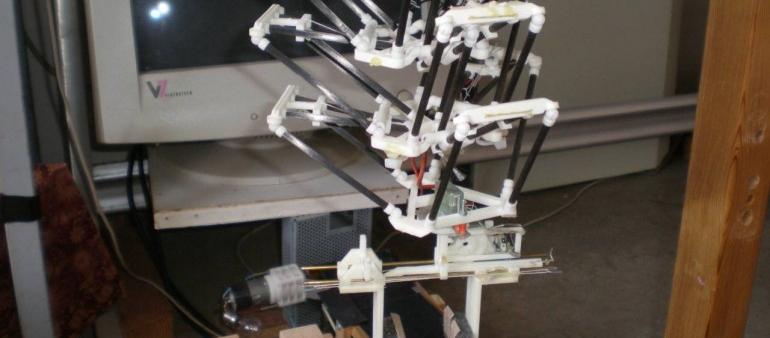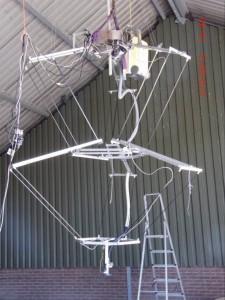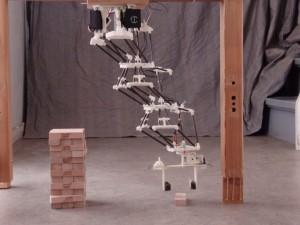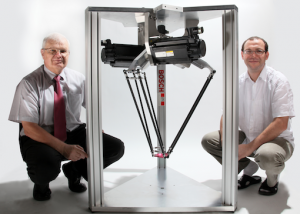Back in the early 1980s, the brilliant Reymond Clavel invented the delta robot.
Clavel, the director of the Laboratoire de Systèmes Robotiques 2 at the École Polytechnique Fédérale de Lausanne in Switzerland, is one of the pioneers in the development of parallel robots and the inventor of the delta robot. His work has resulted in 25 patents and the formation of no fewer than six startup companies.
There have been a whole genre of delta 3D printers created since then (some of them capable of creating enormous parts), but one inventor has outlined a new vision for how delta 3D printers might work.
 When Aad van der Geest saw Clavel’s delta robots for the first time, he was hooked on the efficacy of the idea. It just so happens that van der Geest is an independent developer of software and electromechanical products, and he’s invented systems from special calculators to a full color 3D printer.
When Aad van der Geest saw Clavel’s delta robots for the first time, he was hooked on the efficacy of the idea. It just so happens that van der Geest is an independent developer of software and electromechanical products, and he’s invented systems from special calculators to a full color 3D printer.
As van der Geest got deeper into his examination of the technology, he found what he saw as a major disadvantage with the delta design; the robots can only operate within a relatively small volume, and so the idea for a double or triple delta device came about.
It’s a linkage of multiple delta robot segments. At the core, his idea is simple and elegant: it involves linking multiple delta arms together while leaving heavy control mechanisms and actuators attached to the base.
 As all the actuation is all done from the base and linkages are all controlled from a single point, it’s possible for the arms of van der Geest’s design to be constructed of lightweight – or even featherweight – composite materials. It means the parts of his delta robot which are in motion suffer from very little inertia. It’s that lack of interia which lets the arms of the triple delta robot move at lighting speed and accelerate quickly from rest.
As all the actuation is all done from the base and linkages are all controlled from a single point, it’s possible for the arms of van der Geest’s design to be constructed of lightweight – or even featherweight – composite materials. It means the parts of his delta robot which are in motion suffer from very little inertia. It’s that lack of interia which lets the arms of the triple delta robot move at lighting speed and accelerate quickly from rest.
Because all the arms in the devices are connected to the end-effector, the result is a very stiff overall construction that doesn’t compromise weight and reduce work volume.
The inventor’s three working prototypes – one just 150 mm (6 in) long and the largest measuring more than 11 ft tall – use rotary actuators.
 As part of some recent experiments with vertical linear actuators in a linear delta design, van der Geest says he’s also created a unique style of 3D printer which will, at least theoretically, be capable of large-volume build areas – and all for the sort of price you’d expect to pay for a “conventional” 3D printer.
As part of some recent experiments with vertical linear actuators in a linear delta design, van der Geest says he’s also created a unique style of 3D printer which will, at least theoretically, be capable of large-volume build areas – and all for the sort of price you’d expect to pay for a “conventional” 3D printer.
While van der Geest isn’t ready to announce the completion of any commercial deals for the idea, he does have lots of material which demonstrate how the systems work and their potential. Do you think a double or triple delta 3D printer based on Aad van der Geest’s design could work to make enormous parts? Let us know what you think on the Triple Delta Robot a 3D Printing Gamebreaker forum thread on 3DPB.com.
Subscribe to Our Email Newsletter
Stay up-to-date on all the latest news from the 3D printing industry and receive information and offers from third party vendors.
You May Also Like
Precision at the Microscale: UK Researchers Advance Medical Devices with BMF’s 3D Printing Tech
University of Nottingham researchers are using Boston Micro Fabrication‘s (BMF) 3D printing technology to develop medical devices that improve compatibility with human tissue. Funded by a UK grant, this project...
3D Printing Webinar and Event Roundup: April 21, 2024
It’s another busy week of webinars and events, starting with Hannover Messe in Germany and continuing with Metalcasting Congress, Chinaplas, TechBlick’s Innovation Festival, and more. Stratasys continues its advanced training...
3D Printing Webinar and Event Roundup: March 17, 2024
It’s another busy week of webinars and events, including SALMED 2024 and AM Forum in Berlin. Stratasys continues its in-person training and is offering two webinars, ASTM is holding a...
3D Printed Micro Antenna is 15% Smaller and 6X Lighter
Horizon Microtechnologies has achieved success in creating a high-frequency D-Band horn antenna through micro 3D printing. However, this achievement did not rely solely on 3D printing; it involved a combination...































